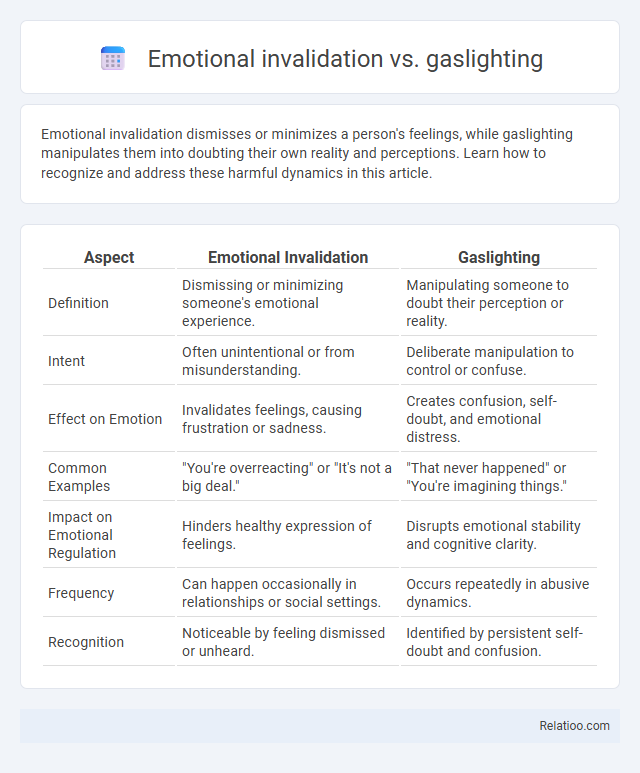Emotional invalidation dismisses or minimizes a person's feelings, while gaslighting manipulates them into doubting their own reality and perceptions. Learn how to recognize and address these harmful dynamics in this article.
Table of Comparison
| Aspect | Emotional Invalidation | Gaslighting |
|---|---|---|
| Definition | Dismissing or minimizing someone's emotional experience. | Manipulating someone to doubt their perception or reality. |
| Intent | Often unintentional or from misunderstanding. | Deliberate manipulation to control or confuse. |
| Effect on Emotion | Invalidates feelings, causing frustration or sadness. | Creates confusion, self-doubt, and emotional distress. |
| Common Examples | "You're overreacting" or "It's not a big deal." | "That never happened" or "You're imagining things." |
| Impact on Emotional Regulation | Hinders healthy expression of feelings. | Disrupts emotional stability and cognitive clarity. |
| Frequency | Can happen occasionally in relationships or social settings. | Occurs repeatedly in abusive dynamics. |
| Recognition | Noticeable by feeling dismissed or unheard. | Identified by persistent self-doubt and confusion. |
Understanding Emotional Invalidation
Emotional invalidation occurs when a person's feelings are dismissed, ignored, or judged, causing them to doubt their emotional experiences and self-worth. Gaslighting goes further by manipulating someone to question their reality and memories, often resulting in severe psychological impact. Recognizing emotional invalidation involves understanding its subtle forms--such as minimizing emotions or refusing to acknowledge feelings--distinct from overt manipulation tactics used in gaslighting.
Defining Gaslighting
Gaslighting is a form of psychological manipulation where one person deliberately distorts facts or events to make another question their reality, memory, or perceptions. Unlike emotional invalidation, which involves dismissing or minimizing your feelings, gaslighting systematically undermines your sense of truth and can severely impact your mental health. Recognizing gaslighting is crucial to protect your emotional well-being and establish healthier boundaries.
Key Differences Between Emotional Invalidation and Gaslighting
Emotional invalidation occurs when a person's feelings are dismissed or trivialized, whereas gaslighting involves intentionally manipulating someone to doubt their perception of reality. The key difference is that gaslighting is a deliberate tactic aimed at psychological control, while emotional invalidation may be unintentional or a result of misunderstanding. Gaslighting often includes lying and distortion of facts, making victims question their memory and sanity, whereas emotional invalidation primarily affects emotional expression and validation.
Common Signs of Emotional Invalidation
Common signs of emotional invalidation include dismissing or minimizing feelings, telling someone they are overreacting or being too sensitive, and ignoring or neglecting emotional expressions. Gaslighting involves manipulating a person to question their own reality or memories, which can overlap with invalidation but specifically targets perception and truth. Emotional invalidation undermines a person's emotional experiences, fostering confusion, self-doubt, and emotional distress.
Recognizing Gaslighting Behaviors
Recognizing gaslighting behaviors involves identifying manipulative tactics designed to make You question Your reality, such as denying facts, trivializing Your feelings, and twisting events to confuse or control. Unlike general emotional invalidation, which disregards or dismisses Your emotions unintentionally, gaslighting is a deliberate strategy to undermine Your confidence and sense of truth. Awareness of these distinct patterns is crucial for protecting Your mental health and maintaining healthy relationships.
Psychological Impact on Victims
Emotional invalidation undermines victims' feelings, leading to increased anxiety, self-doubt, and difficulty regulating emotions. Gaslighting causes profound psychological harm by distorting victims' reality, resulting in confusion, loss of trust in their own perceptions, and diminished self-esteem. Both emotional invalidation and gaslighting contribute to long-term trauma, but gaslighting's manipulation intensifies feelings of helplessness and cognitive disorientation.
Why Emotional Invalidation Happens
Emotional invalidation happens because individuals may lack the emotional awareness or communication skills necessary to acknowledge others' feelings, often dismissing them as irrational or exaggerated. Gaslighting, a more deliberate form of manipulation, occurs when someone aims to distort another's perception of reality to maintain control or power, making you question your own experiences and emotions. Understanding why emotional invalidation happens can help you recognize toxic patterns and foster healthier emotional validation in relationships.
Motivations Behind Gaslighting
Gaslighting is a manipulative tactic aimed at controlling and confusing you by denying your reality, often motivated by a desire for power or to avoid accountability. Emotional invalidation, while hurtful, usually stems from misunderstandings or emotional immaturity rather than deliberate manipulation. Recognizing these distinctions helps protect your emotional well-being and assert your reality against intentional gaslighting.
How to Respond to Emotional Invalidation and Gaslighting
Responding to emotional invalidation involves calmly asserting your feelings and setting clear boundaries to protect your emotional well-being. When facing gaslighting, document conversations and seek external support from trusted friends or mental health professionals to validate your reality. Prioritize self-care and professional guidance to effectively navigate and counteract both emotional invalidation and gaslighting tactics.
Healing and Recovery Strategies
Healing from emotional invalidation involves recognizing and validating personal feelings, setting clear boundaries, and seeking supportive relationships that affirm one's emotional experiences. Recovery from gaslighting requires rebuilding self-trust through cognitive-behavioral techniques, therapy focused on trauma recovery, and establishing a strong support network to reinforce reality and personal truth. Effective strategies for overcoming emotional abuse patterns combine mindfulness practices, professional counseling, and consistent self-affirmation to restore emotional health and resilience.

Infographic: Emotional invalidation vs Gaslighting
 relatioo.com
relatioo.com